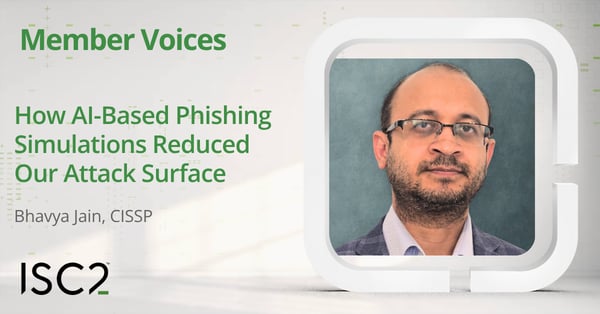Phishing attacks continue to spread around the digital world, exploiting human vulnerabilities to penetrate business defense systems. Bhavya Jain, CISSP, explains how and why he deployed AI-based phishing simulations to mitigate the threat posed to his organization and colleagues.
 Disclaimer: The views and opinions expressed in this article belong solely to the author and do not necessarily reflect those of ISC2.
Disclaimer: The views and opinions expressed in this article belong solely to the author and do not necessarily reflect those of ISC2.
Attackers have improved their spear-phishing and CEO fraud methods, but traditional approaches to defense currently failing to keep pace.
I introduced AI-driven phishing simulations as a key strategy against such threats, while simultaneously developing a security-conscious workforce. Adaptive machine learning and behavioral analytics serve as the foundation for our organization to decrease its exposure and for educating staff in security alertness, better safeguarding against potential attacks. Fundamentally, the success of our initiative is founded on a gamified incentive structure, which motivates staff to participate. Essentially, employees receive points for successfully identifying and reporting phishing attempts.
Predictive Cybersecurity Analytics: Anticipating Social Engineering Attacks With AI
The adoption of predictive cybersecurity analytics revolutionized my method for facing social engineering threats, while developing a balance between new technology systems and caring for human users: we enabled real-time threat adjustment and behavioral assessment through AI, resulting in better attack prediction and the development of employee readiness capabilities.
However, our predictive approach encountered major obstacles despite initially showing promising potential. The first versions of predictive systems encountered problems when adversaries attacked them through manipulated training data which enabled them to evade detection: criminal actors used carefully placed linguistic mistakes in their communications to trick AI evaluation systems into assigning them harmless status. I responded by providing the model with deceptive development samples to strengthen its effectiveness against adversarial attacks. The system’s development became more robust through this technique, which lowered false negative results by 28%.
Employee trust became a major obstacle that appeared in the experiment. Staff members resisted behavior monitoring technology because they thought performance assessment methods would focus on punishment rather than learning opportunities.
What Worked: Strategic Incentivization and Targeted Campaigns
Here are the aspects of our approach that were successful:
- Gamified Reward System: I introduced a badge-based incentive program where employees earned points for consecutively identifying and reporting phishing attempts – for example, 10 points for two consecutive reports, 50 points for 10 reports. This increased participation by 62% within three months.
- Annual Recognition for Top Performers: The three employees with the highest annual points received monetary bonuses and public recognition during company-wide meetings, fostering a culture where vigilance became aspirational.
- Department-Specific Campaigns: Focused simulations targeting high-risk teams like customer care and sales reduced susceptibility by 45% over six months. Role-specific lures were used, such as fake payment requests for sales teams and spoofed service tickets for support staff.
- Adaptive AI Content: The difficulty level of simulations was dynamically adjusted based on employee behavior. For example, staff who clicked phishing links received follow-up training with more nuanced threats, cutting false negatives by 33%.
Metrics
Like any experiment, we tracked metrics to determine its success. Here are the Key Performance Indicators (KPIs) we measured:
- Reduction in Phishing Susceptibility: Our AI-driven simulations decreased employee click rates by 45% within six months, directly reducing organizational risk.
- Faster Incident Reporting: Employees who reported simulated phishing emails within 5 minutes were 89% less likely to fall for real attacks, making speed a critical leading indicator.
- Fewer Security Incidents: Regular simulations led to a 70% decline in successful phishing breaches, aligning with industry benchmarks.
- Improved Resilience in High-Risk Departments: Customer care and sales teams, initially the most vulnerable, achieved a 50% faster reporting rate after targeted training.
Challenges and Considerations When Deploying AI-Based Phishing Simulations
Initial Staff Resistance
Employees perceived simulations as surveillance tools, leading to distrust and non-participation. Complaints surged by 40% during the first month. To resolve this, I changed the message to emphasize collective security over individual blame. We also introduced anonymous performance tracking and hosted town halls to clarify simulation goals, reducing pushback by 78% within two months.
Static Phishing Templates
Our early simulations used generic email templates, such as fake "password reset" requests. Employees quickly recognized these, leading to a 25% false-negative rate. To resolve this, we used AI-generated content that mimics real-world threats – such as CEO fraud and invoice scams – and adjusted the difficulty dynamically according to employee behavior. This cut false negatives by 33%.
Adversarial Attacks on AI Models
Attackers attempted to poison our training data by feeding deceptive inputs, thus risking our model integrity. We deployed adversarial training techniques and ensemble learning to harden our AI against such manipulation and ensuring simulations remained resilient.
Data Privacy Concerns
In an extension of the initial staff resistance described above, behavioral tracking for personalized simulations raised ongoing employee fears about surveillance. The solution to this was to implemented strict anonymization protocols and transparent data-handling policies, with regular audits to maintain staff trust.
Complacency Arising from Repetition
Our staff grew overconfident after repeated exposure to similar scenarios, to the extent that click rates rebounded by 15% after six months. To mitigate against this, we introduced escalating difficulty levels and randomized threat types (e.g., SMS phishing, QR code scams) to sustain engagement.
Recommendations Based on Our Experiences
By addressing each of these challenges with tailored responses, I turned AI-based phishing simulations into a cornerstone of my organization’s defense-in-depth approach, significantly shrinking the attack surface while fostering a culture of shared responsibility.
Implementing AI-driven phishing simulations transformed our organizational security posture - but the journey required (and continues to require) continuous adaptation. Here are the key lessons I learned, with recommendations for other ISC2 members seeking to replicate this success while avoiding common pitfalls:
- Start With Your Highest-Risk Departments: Pilot simulations in teams handling sensitive data or external communications, such as finance and HR. Focusing on finance first allowed us to refine scenarios before enterprise-wide rollout, reducing initial configuration errors by 40%.
- Align Incentives with Organizational Culture: Combine non-monetary recognition such as badges or internal certifications with periodic rewards. We found quarterly micro-bonuses (for example, gift cards for top monthly performers) sustained engagement better than annual prizes alone.
- Leverage Adaptive AI Sparingly: While AI-generated phishing content improves realism, over-reliance can alienate employees. Balance algorithmic complexity with transparency: explain how simulations evolve and provide post-campaign breakdowns of detected tactics.
- Measure Beyond Click Rates: Track secondary metrics like reporting speed and false positive rates. In our case, employees who reported simulations within five minutes were 89% less likely to fall for real attacks, making this a leading indicator of program efficacy.
- Conduct Compassionate Remediation: Avoid punishment for simulation failures. Instead, try pairing at-risk employees with security mentors – this strategy that improved repeat offender resilience by 57% in my organization.
Finally, remember that the road to resilience is iterative. Start small, celebrate incremental wins, and remain agile as both threats and defensive tools evolve.
Bhavya Jain, CISSP, has 15 years of experience in fintech, banking, consulting, law firms and services industry. He has held management and technical lead roles, with responsibility for executing security strategy, threat detection and response, compliance and risk mitigation. His cybersecurity work spans threat detection, incident response, application and cloud security, AI-driven defense and governance, risk and compliance.
Related Insights


